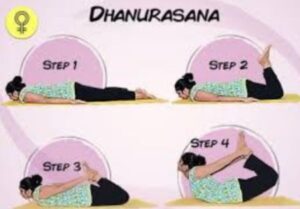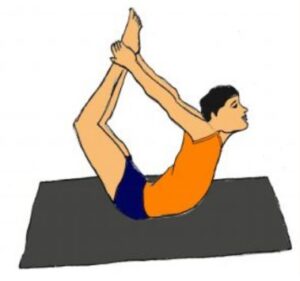“Pranayama. Stopping the right nostril with the thumb, through the left nostril fill in air, according to capacity; then, without any interval, throw the air out through the right nostril, closing the left one. Again inhaling through the right nostril eject through the left, according to capacity; practicing this three or five times at four hours of the day, before dawn, during midday, in the evening, and at midnight, in fifteen days or a month purity of the nerves is attained; then begins Pranayama.” Explained by Swami Vivekananda.
The meaning of the Sanskrit word Dhanurasana means the yoga posture which resembles the shape of a bow. The word Dhanu means bow and asana mean yogic posture (Somlata Jadoun, Rana, & Yadav, 2020). While practicing yoga, the body of the practitioners takes the shape of a bow. Hence, another name for this pose is the Arrow pose. This yoga involves the stretching of both the hands and the legs. The beginners should hold the position for one to two minutes. Later, after gaining stamina, they can be able to hold the pose for two to three minutes.

How would it benefit the practitioners??!!
This posture leaves pressure on the abdomen, which helps in strengthening the abdomen muscles. It in turn helps in improving the functions of the internal organs, such as the liver, kidney, pancreas, adrenal, and so on (Yogasan, 2018). By improving the functioning of these organs, this pose is beneficial in improving the digestive system and reproductive systems of the body. Hence, the regular practice of this yoga helps the practitioners in curing the problems related to indigestion, infertility, and constipation. Dhanurasna helps in improving the blood circulation of the body and helps in gradually curing the problems related to the stomach. With the help of the stretching of arms and legs and the pressure on the abdomen, it helps in reducing the extra fat from this region (Yogasan, 2018). Thus it helps in maintaining the proper bodyweight of the practitioners. Proper stretching while doing this yoga, will help in making the muscles of the back and spine more flexible and in removing the hunch. Women suffering from menstrual irregularity and disorders can also gain benefits from this pose. Regular practicing of this yoga helps in curing diabetes. The stretching of the body also helps in improving the functions of the lungs, thus it improves the respiratory system. It helps in reaching oxygen-rich blood to the whole parts of the body, and in fighting against Asthma and other ailments related to the respiratory system.

Things to remember!!!
Yoga involves the bending of the spinal cord region. Hence, individuals with the stiffness of the spinal cord cannot practice this yoga (Yogasan, 2018). The yoga instructors suggest that pregnant women not practice yoga, as it leaves pressure on the abdomen. Individuals suffering from heart disease should also avoid practicing this yoga. The instructors suggest the practitioners not practice this yoga before bedtime (Somlata Jadoun, Rana, & Yadav, 2020). It can disturb sleep. People suffering from high blood pressure, hernia, abdominal ulcer, and any kind of bowel disease should not practice this yoga. They should consult doctors and well-trained instructors before practicing this yoga.
Safety precautions!
The practitioners are instructed not to strain the body while they are doing yoga. The instructors suggest the practitioners not put much pressure and hold for a long time (Somlata Jadoun, Rana, & Yadav, 2020). They should practice the yoga accodr4ing to their capacity.
References
Somlata Jadoun, D., Rana, A., & Yadav, S. K. (2020). An Anatomical Exploration of “Dhanurasana”. Retrieved from https://www.searchdl.org/Resources/Public/Jnl/IJTSRD/4/4/ijtsrd30878.pdf
Yogasan. (2018). Dhanurasana. Retrieved from yogasan.com: https://101yogasan.com/constipation/dhanurasana.htm